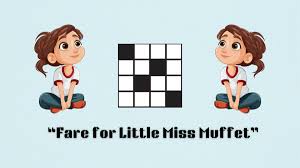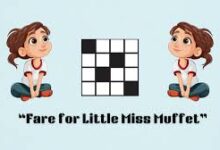Fare for Little Miss Muffet NYT: What This Funny Clue Really Means

Fare for little miss muffet nyt might sound like a menu from an old-timey tea party, but it’s actually a clever clue from the New York Times crossword. This puzzle clue is fun, tricky, and makes you think about nursery rhymes in a whole new way. Many solvers get stumped by it because it mixes food with a famous rhyme. If you’ve ever scratched your head and thought, “What could fare mean for Miss Muffet?”—don’t worry, you’re not alone! This post is made just for you.
In this guide, we’ll explore what the clue really means, where it came from, and how to solve it easily. You don’t need to be a puzzle pro or a history buff—just someone who’s curious and loves wordplay. Keep reading, and you’ll feel like a crossword champ in no time. We’ll even break it down using super simple words so it’s easy for everyone to understand.
What Does “Fare for Little Miss Muffet NYT” Mean in Crossword Puzzles?
The phrase “fare for little miss muffet nyt” is a fun crossword clue from the New York Times. In the rhyme, Miss Muffet eats something called “curds and whey.” The word “fare” is another way to say “food.” So this clue is asking what food Miss Muffet had in the rhyme. The answer is “curds and whey.” Many people get stuck because “fare” is not a word we use every day. But once you know it means food, the clue becomes simple! This clue is a great example of how NYT crosswords play with words from songs and stories we knew as kids. It mixes old rhymes with tricky thinking. If you love word games, clues like this are fun to figure out. Just remember: sometimes the best way to solve a clue is to think like a kid who remembers nursery rhymes.
Easy Guide: How to Solve Fare for Little Miss Muffet NYT Clue
Solving the “fare for little miss muffet nyt” clue is easy when you know the rhyme. First, read the clue slowly. Think about what Miss Muffet was doing in the rhyme. She was “eating her curds and whey.” That’s your big hint! Now, look at the word “fare”—it means food. So now the clue is really just asking: “What food did Miss Muffet eat?” The answer is “curds and whey.” In most puzzles, this will fit the boxes. If not, just try a shorter version like “curds.” Crossword clues sometimes use fancy or old words like “fare” to make you think harder. Don’t feel bad if it takes time to get it. Clues like these are meant to be fun and make your brain work in a cool way. Keep trying, and you’ll get better with every puzzle!
From Nursery Rhyme to Puzzle: The Fun Behind the Fare for Little Miss Muffet NYT
The clue “fare for little miss muffet nyt” brings a childhood rhyme into an adult brain game. That’s what makes it so fun! It’s like mixing school-time poems with grown-up word puzzles. The rhyme is super old, first written in the 1800s. Back then, people really did eat curds and whey, which is kind of like yogurt. Crossword makers love using these rhymes because they’re familiar to many people, and they give clues a playful twist. It’s cool how something so old still shows up in modern puzzles! These clues help make crosswords more fun and not just full of boring facts. You’ll notice that lots of NYT puzzles use things like fairy tales, poems, and rhymes to make the game feel creative and interesting. So, the next time you see a silly rhyme in a clue, don’t skip it—use it to win!
Why the NYT Uses Clues Like Fare for Little Miss Muffet
The New York Times crossword loves using clues from rhymes like Miss Muffet because they mix fun and learning. Clues like “fare for little miss muffet nyt” are playful, but they also test your thinking. You have to remember the rhyme and figure out what the word “fare” really means. This kind of clue teaches you how to connect different ideas—like poems and food. It’s also a nice break from clues about history or science. People like puzzles that make them smile or feel smart when they solve them. That’s why clues from stories we learned as kids work so well. They make us feel happy and clever at the same time. Puzzle makers pick clues that surprise us and make us say, “Oh! I get it now!” That little “aha!” moment is what makes these puzzles so much fun to play.
Curds and Whey? A Look at the Real Fare for Little Miss Muffet
So what exactly are “curds and whey,” the real fare for Miss Muffet? It might sound strange, but it’s a real food! Curds are the thick part of milk after it starts to turn into cheese. Whey is the watery part that’s left. Long ago, people ate curds and whey as a healthy meal or snack. It’s kind of like eating cottage cheese today. In the rhyme, Miss Muffet sits quietly, eating this food before a spider comes along and scares her. The NYT crossword clue “fare for little miss muffet” is asking you to remember this funny moment and name the food. So, curds and whey is not just a silly rhyme—it’s a clue answer, a real food, and a fun way to learn how words can mean different things. The next time you see this clue, you’ll be ready with the answer!
Conclusion
Now you know what fare for little miss muffet nyt means and how to solve it. It’s not just a hard clue—it’s a fun one too! If you remember old rhymes, you’ll start finding clues like this much easier. Crossword puzzles become more exciting when they mix childhood fun with word skills.
Keep solving puzzles and learning new tricks. Every rhyme, every clue, and every answer helps you grow your brain. And hey, who knew “curds and whey” could be part of a puzzle? The more you play, the more you’ll enjoy it. Let puzzles like this be your daily brain snack!
FAQs
Q: What does “fare for little miss muffet nyt” mean?
A: It means the food Miss Muffet ate—“curds and whey”—in the rhyme.
Q: What is “fare” in crossword clues?
A: “Fare” usually means food or something to eat in crossword puzzles.
Q: Is “curds and whey” a real food?
A: Yes! It’s an old dish made from milk, like cottage cheese.
Q: Why does the NYT use nursery rhymes in clues?
A: Because they are fun, familiar, and make puzzles more playful.
Q: Can this clue have more than one answer?
A: Most of the time, the answer is “curds and whey,” but some puzzles might use just “curds.”

